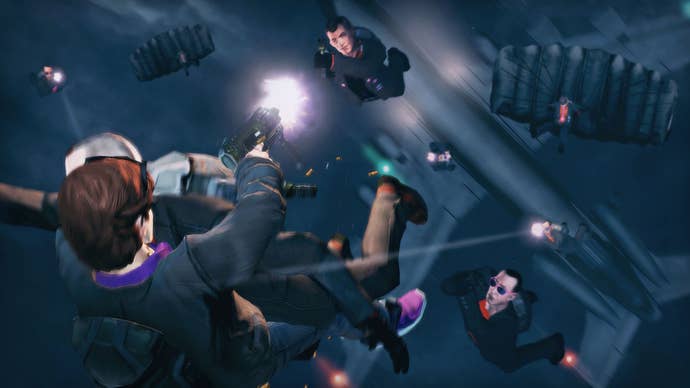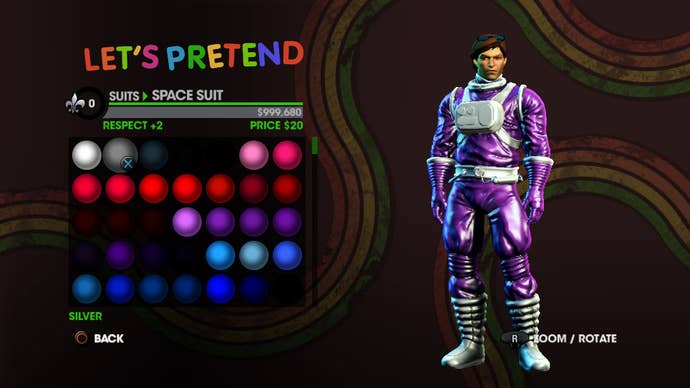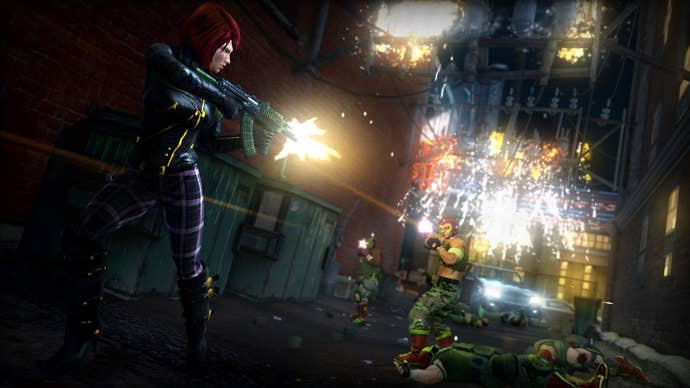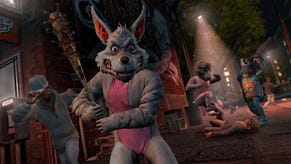My First Encounter with the Saints
Ahead of the impending release of Saints Row IV, Pete looks back at this odd series' third installment.
This article first appeared on USgamer, a partner publication of VG247. Some content, such as this article, has been migrated to VG247 for posterity after USgamer's closure - but it has not been edited or further vetted by the VG247 team.
I've been playing Saints Row IV recently and I desperately, desperately want to talk about it.
However, I can't just yet. So I thought I'd do the next best thing and talk about Saints Row The Third, which is, for many people, the real star of the Humble Bundle that's running at the time of writing. Saints Row The Third was also my first encounter with this series.
It's impossible to talk about Saints Row without mentioning Grand Theft Auto, for the two are very similar at first glance. Both take place in an urban open world; both feature a blend of linear narrative and non-linear side content; both afford the player the freedom to run wild in what a friend of mine refers to as "underpants mayhem" -- a phenomenon that will likely be well familiar to any parents out there, where a young child (usually around the age of two or three) will strip down to their underpants, run around screaming and generally cause chaos. The difference in Saints Row and Grand Theft Auto's underpants mayhem, of course, is that the instigator of said mayhem is a fully-grown adult, usually armed with a selection of high-powered weaponry.
But while the two series began as bedfellows, thematically at least, over time they've drifted apart from one another. Grand Theft Auto gradually started taking itself a bit more seriously, placing a much stronger focus on telling a gripping "criminal underworld" story, while Saints Row instead focused on the more chaotic side of things.

It's immediately apparent from the very beginning of Saints Row The Third that this isn't going to be your usual "street scoundrel works his way up to the top of the underworld" story. For starters, Saints Row The Third begins with the 3rd Street Saints having already broken through the top of the underworld and into the mainstream -- they're celebrities, with their own brands of clothing, body spray and, as popular recurring character Johnny Gat puts it, "some ass-tasting energy drink."
This clash between the Saints' roots and their new-found power and popularity is a central theme of the story. At a number of points throughout the game, you're presented with alternative resolutions to a mission -- on a meta level, these are mocking the binary moral choices seen in games like BioShock, but in narrative terms, they're forcing the player to make a choice between staying true to the gang's roots, or fully embracing their new celebrity lifestyle. These choices continue throughout the whole game's major story beats, culminating in two completely different finales depending on the way you choose to play.
The story itself is actually rather fun, and reason enough to play the game -- I won't spoil it for you here. At first glance, it'd be understandable if you dismissed Saints Row as just another "gangland" experience, but over time it becomes apparent that the characters have all been crafted to be endearing, amusing and sympathetic, if somewhat exaggerated. They're certainly memorable, though; there's no-one who feels like a "filler" character, and everyone has their own defining characteristics.
In an interesting twist on the Grand Theft Auto formula, the protagonist has their own personality, but this is determined to a significant degree by the player. The combination of gender, appearance, clothing and voice that you choose for your character can have a significant impact on how "seriously" you take the game, and what sort of person you perceive the protagonist as. At the "comedy" end of the spectrum is the "Zombie" voice, which simply replaces all the protagonist's dialog with guttural groans and wheezes, but helpfully provides subtitles. If you want to take things a bit more seriously, there's a mix of different male and female voices to choose from, with no obligation to match the voice to the character's physical appearance. Each voice set has its own personality, and little bits of the game change slightly depending on which voice you're using -- at one point, circumstances demand that the protagonist give their "last words" before they die, with each different voice having a completely different (and usually hilarious) "confession" to make.

Moving away from the story, in game terms there is a ton to do in Saints Row The Third, and most of it is available to you either from the outset or very early on in the game. You can clear out enemy bases to capture territory; engage in "Mayhem" missions (either on foot or in a tank); run races; drive around while people... entertain each other in your back seat; or even drive around with a tiger as your passenger.
Each of these "Activities," as they're called, is distinct from one another, and everyone will doubtless find their favorites. Some, like the aforementioned Mayhem missions, are chaotic arcade-style experiences in which you simply blast everything in sight; others, like the Professor Genki missions, require you to take your time a little more and carefully but efficiently work your way through traps and other challenges. Others still, like the hilarious Insurance fraud missions -- effectively Saints Row's answer to Burnout Paradise's "Showtime" mode, only with it being your ragdoll body that is getting thrown around rather than a car.
And then there's the cooperative mode. You could, of course, play Grand Theft Auto IV in multiplayer and just ride around causing random acts of violence, but most online sessions usually ended up as a more structured game before long. Saints Row IV's co-op mode, meanwhile, just drops a second player into the standard game structure, allowing you to do as you please together: ride around and cause carnage, indulge in Activities or even work your way through the story. There's something incredibly satisfying and enjoyable about sharing the experience with a friend -- particularly when you both get to play as your own custom-designed characters. Your avatar becomes more than just the character you see on screen; it becomes your means of expressing your personality to another person -- something which the team at Volition has run with with the community-sharing features for custom characters.

It's easy to dismiss Saints Row The Third as pure, dumb, puerile fun and on a certain level it is; on another, however, it's in possession of a sharp, witty and very intelligent sense of humor, and everything it does is done for a reason.
Take the matter of collectible items. In the Grand Theft Auto series, these were never given any real context -- they were just scattered around the game world seemingly at random, and acquiring increasingly large numbers of them rewarded you with benefits such as easy access to weapons. Saints Row The Third initially appears to be much the same -- early in the game, you're invited to start collecting inflatable sex dolls, money pallets and drug packages. However, pay close attention and you'll see that there actually is a reason for these bizarre items to be scattered all over town -- the second mission of the game involves, for various reasons, falling out of an airplane, and eagle-eyed players will notice that the contents of the plane include, you guessed it, boxes of sex dolls, packages of drugs and pallets of money.
There's also plenty of subtle fourth-wall breaking throughout the game. You'll actually come across your first sex doll as part of one of the missions, which leads to an amusing conversation with supporting character Pierce; elsewhere, the characters will joke about periods of time being measured in "waves of SWAT units," and DJs on the in-game radio stations will sometimes address the player directly. It's a game that is keenly aware of its own absurdity throughout, and revels in the disconnect between player-created chaos and scripted narrative.
And that's what makes it special. Saints Row is very much aware of both what it is and what it is not, and it loves what it is, unashamedly so. Having grown somewhat weary of the Grand Theft Auto series ever since I never finished San Andreas, I very much love what it is, too. Saints Row The Third is an excellent game that is well worth your time, even with Saints Row IV on the horizon.
As for Saints Row IV? Well, you'll have to wait for our review, won't you?















